Categories: Featured Articles » Sources of light
Number of views: 29050
Comments on the article: 0
Malfunctions of luminaires with fluorescent lamps and their repair
Fluorescent lamps (LL) are used for lighting and now, despite the fact that LED lamps make them a strong competition. Linear tubular lamps are more often installed in offices, garages, at enterprises, compact fluorescent lamps (CFLs) are installed in everyday life and in the same types of premises as listed above. For them there are characteristic malfunctions, so in this article we will consider how to fix a fluorescent lamp.

Design description
Fluorescent lamps differ in the shape of a tubular bulb, they are:
-
Linear.
-
Curly.
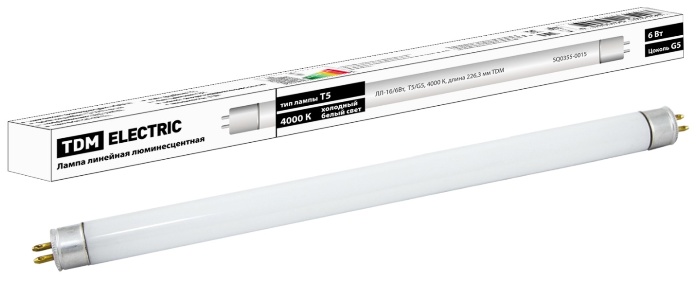
It is typical for CFL, where the flask is a tube twisted into a spiral or U-shaped. This is necessary to reduce the size while maintaining the length and area of the emitted surface.

In the general case, the bulb of a fluorescent lamp is a glass tube into which mercury vapor and inert gases are pumped. Two spirals are installed in the flask, one at each of its ends.
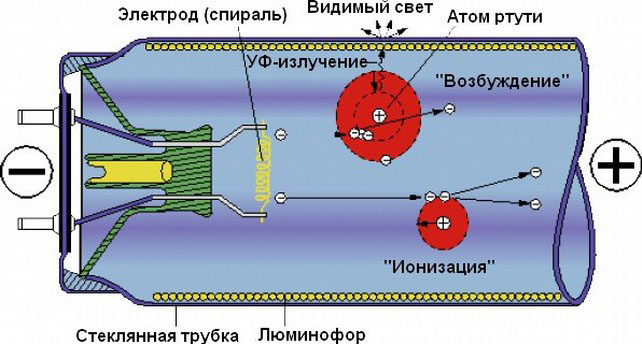
When the discharge is burning, ultraviolet is emitted in the lamp to convert it into visible light. The inner surface of the bulb is covered with phosphor layers.
Tubes come in different diameters and lengths. Usually the longer the lamp, the more powerful it is.

As already mentioned, such lamps have two spirals. They are needed to heat the gases and power the lamp after it is started. Two pin contacts from the spirals from each side come out of the flask.

This type of connection is called a pin base of type G. Depending on the distance between the terminals, there are distinguished socles of type G13 and G5. Which pins are located at a distance of 13 and 5 mm, respectively.

Power scheme and normal operation
Fluorescent lamps differ from ordinary ones in that for their operation it is not enough just to connect its terminals to an AC 220V. The power scheme involves the operation of a fluorescent lamp with the so-called ballast - ballasting apparatus. They are of two types:
-
Electromagnetic (EmPRA);
-
Electronic (electronic ballast).
Electromagnetic ballasts are considered obsolete, but are still often used to this day. They are not so effective and give light with barely noticeable flickers (low ripple coefficient), but they are reliable and easy to repair. Therefore, let us consider them first.
To light a lamp, you need to break through its gas gap; for this, you need to create an increased voltage pulse. Therefore, an energy storage device, a choke, is installed in series with the lamp.
But such a scheme will not work anyway, you need to control the process of heating the spirals and the accumulation of energy. The spirals are heated to provoke the emission of electrons, as a result of which a discharge should occur in the ionized gas. In tubular fluorescent lamps, the discharge is smoldering.

Therefore, a starter is installed parallel to the lamp. Inside the starter there is a neon bulb (like the one in your indicator screwdriver or in the backlight of the switch) inside which bimetallic contact plates act as electrodes.
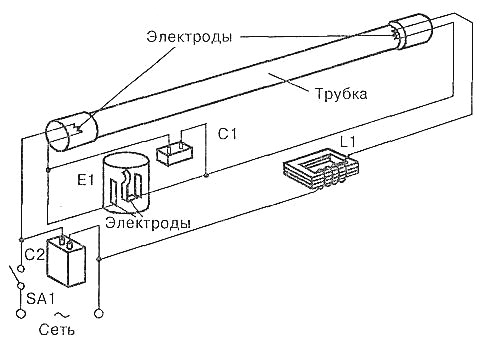
When you apply voltage to the circuit, the cold bimetallic contacts are closed, through them and two spirals with which it is connected in series, current flows.
The spirals heat up and the bimetal heats up until the starter contacts open. Then the energy accumulated in the inductor will tend to maintain the flow of current, as a result of which the voltage on the lamp begins to increase until a breakdown occurs or the starter contacts have cooled down, they will close and the process of heating the spirals will start again.
In addition to the starter and inductor, luminaires install capacitors to suppress interference, but not always.
Scheme of a raster lamp with 4 lamps, where two fluorescent lamps are connected to one inductor.
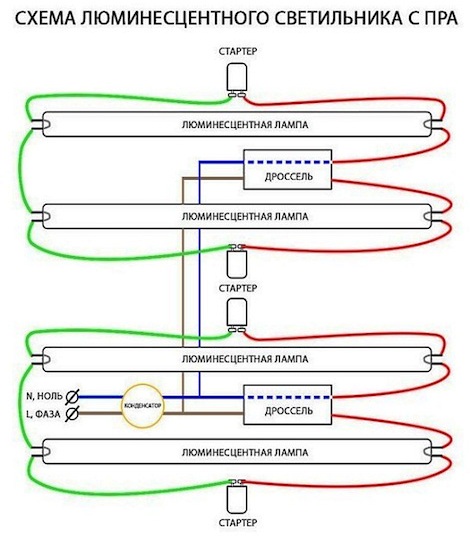
Scheme of a luminaire with one fluorescent lamp:

Electronic ballasts are more complex. It uses the phenomenon of voltage resonance. Its circuitry is based on a high-frequency switching power supply, which is loaded on the inductor in series, and a capacitor connected in parallel with the lamp. The principle of electronic ballasts is worthy of description in a separate article - How are electronic ballasts arranged and working?.

It is connected easier than the EMPA, the circuit is applied to the epr housing and the connection consists in supplying power to the terminals marked with the letters L1 and L2. And the lamp is connected to the remaining two pairs of terminals.
Typical EMPR faults and their repair
Let's get acquainted what malfunctions can occur in the circuit with a starter and a throttle:
1. The lamp does not turn on.
2. The lamp glows dimly at the edges, but does not light up.
3. The lamp starts to glow dimly at the edges, flashes brightly and goes out again.
4. The lamp shines dimly or flickers are noticeable.
5. Along the tube light “runs”, uneven illumination, or similar phenomena.
6. The lamp lights up, but the edges of the tube are black.
These are the main problems with fluorescent lamps, consider the ways to eliminate them. If the lamp does not turn on at all, check:
1. Is voltage coming to the lamp at all? If not, look for a break in the power line.
2. Remove the lamp from the lampholders to check for spirals. To do this, rotate it along its axis and remove the pins from the meshing of the cartridges. Now you need to check if the spirals are broken by a proverb or a tester. If they do not “ring”, it means that they are burnt out, that is, torn off. In this case, you need to replace the lamp.
3. Check if there are any contacts in the cartridge and in what condition they are.
4. Remove the starter and install a known-good starter. If its contacts are destroyed - the heating process will not occur, the lamp will not turn on.
5. Measure throttle resistance:
-
If it is infinite - it burned out, under the replacement.
-
If it is below 40 Ohms - inter-turn circuit. In this case, the lamps may work, but quickly burn out - the throttle must be replaced.
-
If the resistance is generally zero - it means in the short circuit choke. The lamps will not turn on, and the starter will repeat the process of igniting the fluorescent lamp again and again - under the replacement.
-
If the ohmmeter is not at hand, you can partially check with the usual dialing - if the circuit is normal (the indicator beeps / lights up), then the throttle is definitely not open, but a short circuit is possible. And if the nickname does not ring or does not burn, the throttle is in a cliff. Now you can check the short circuit of the winding on the case, it should not be.
Electronic choke for a fluorescent lamp: circuit, device and malfunctions
Most electronic ballasts that are used to power fluorescent lamps are built according to a simple scheme based on a self-oscillator.
Scheme:
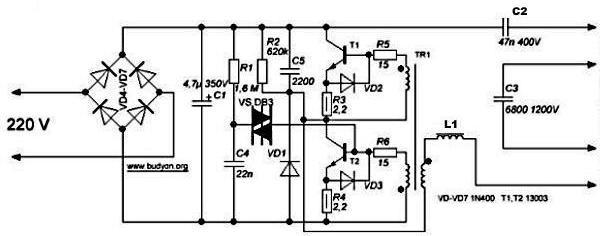
A similar scheme, but on a round-shaped board, is in energy saving (CFL).
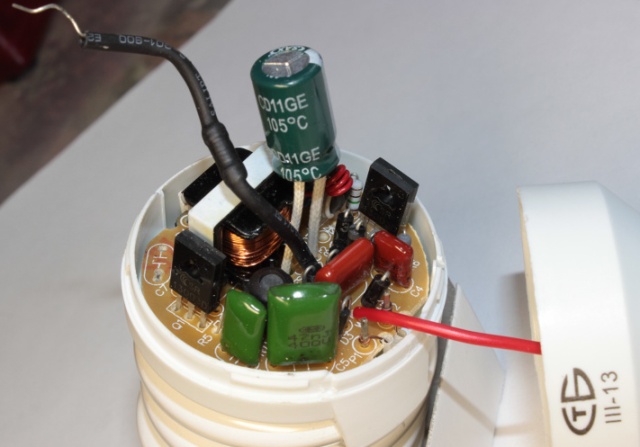
The figure below highlights the elements that burn most often.

Diodes typically use type 1n4007 and similar low power ones. Transistors, depending on the power of the lamp, it is usually the line MJE13001, 13003, 13009 and the like.
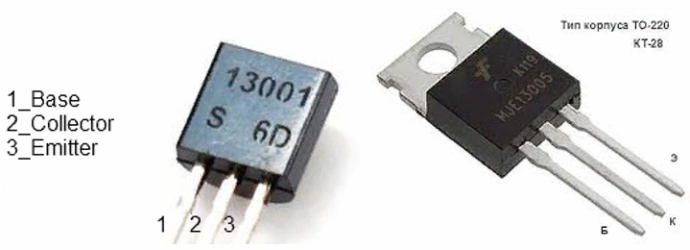
In many situations, when you need to quickly repair a lamp, it’s easier to replace the electronic ballasts completely, and take the burned-out home for inspection and repair “in reserve”.
Conclusion
The power supply and repair of fluorescent lamps is not as complicated as it may seem and is easy to repair. If you use such lights in a garage or workshop - I advise you to keep several working starters, just in case. They fail most often.
See also at bgv.electricianexp.com
:
